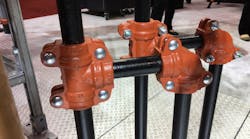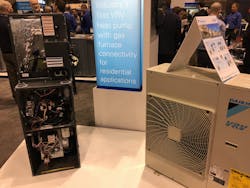Latest from AHR
Sponsored
CHICAGO — Two trends appeared at the AHR Expo in Chicago recently, one a big macro market-moving trend and the other a small installation-related trend that is, nevertheless, useful to contractors.
The macro trend involves large OEMs broadening their product lines so that they can offer contractors and engineers a solution to just about any challenge they face. A number of years ago Bradford White Water Heaters bought boiler maker Laars and that was followed by A.O. Smith purchasing Lochinvar. Paul W. Jones, A.O. Smith chairman and chief executive officer, commented at the time that, “This acquisition fits squarely within our stated strategy to expand our core product offering with new technologies, which emphasize high-efficiency products that can be applied globally.” The strategy seems to be spreading to HVAC OEMs.
Less than a week before the start of AHR, Trane and Mitsubishi announced that they have entered into an agreement to establish a 50 percent-50 percent joint venture. The purpose of the joint venture would be the marketing, sales and distribution of ductless and VRF heating and air conditioning systems through Ingersoll Rand’s Trane and American Standard commercial and residential channels, and existing Mitsubishi Electric distributors and representatives in the U.S and Central and South America. The products would include variable-speed mini-split, multi-split, and VRF air conditioners and heat pumps for homes, light commercial and commercial applications.
Daikin was the first to offer a full line of both ducted and ductless HVAC systems with its purchases of McQuay and American Air Filter and its July 2012 acquisition of Houston-based Goodman Global. Daikin displayed its VRV Life systems at the show, the industry’s first VRV heat pump paired with one or more gas furnaces for single-family home applications. Daikin is, no doubt, taking advantage of everything that it has learned from its acquisition of Goodman, and also acknowledging some of the realities of the American market.
The second trend isn’t earth-shattering but contractors make use of it every day. There was a lot of pipe joining technology seen at the show.
Preferences of the American market was one of the reasons why Mitsubishi came out with add-on air handlers with electric heaters.
China’s Midea likewise was showing American-style condensing units along with multi-positions air handlers for cooling or heat pump applications with optional field-installed electric heater kits.
Daikin believes that VRV comprises 12 percent of the American market while Mitsubishi thinks it’s more like six percent but growing by double digits. They both agree that globally VRV has 40 percent-plus market share. With the market split that way, OEMs will need to have boilers, chillers and unitary equipment, as well as mini-splits and VRVs.
The second trend isn’t earth-shattering but contractors make use of it every day. There was a lot of pipe joining technology seen at the show.
Victaulic showed its recently announced grooved coupling system for Schedules 40 and 80 CPVC and PVC pipe. The system includes a full line couplings, fittings and pipe preparation tools. Victaulic was also displaying a brand-new coupling for carbon steel pipe down to ½-inch in diameter. The couplings are preassembled and the firm maintains that the couplings are cheaper and install faster than competitive systems. The new couplings, spec' out at 300-PSI and 250°F, should be out in the market by the end of the first quarter.
Viega LLC introduced Viega MegaPress XL, a press fitting system for 2½-inch to 4-inch diameter carbon steel pipe. Viega also introduced the Viega MegaPress XL PressBooster, a unique tool designed for larger diameters using an existing 300 Series RIDGID press tool. The press tool, suitable for use with Schedule 10 to Schedule 40 carbon steel pipe, was also on display at the Ridge Tool section of the Emerson booth at AHR.
Greenlee was showing its Gorilla pressing tools. The company’s inline pressing tool has a fitting capacity of 1½-inch on PEX and 1-1/4-inch on copper and stainless steel, and the pistol grip pressing tool has a fitting capacity of 2-inch on PEX and 4-inch on copper and stainless steel. The tools have a patented twist and release pin, making jaw exchange easier. The kits come with four jaws for the inline and six for the pistol grip.
Finally, Rehau showed the belt and suspenders of fitting systems, its Everloc+. The system includes the pipe, the fittings and the joining tool. PEXa, when expanded, will revert to its original diameter. The Everloc+ system uses an expansion tool to expand the pipe and the fitting is then inserted. In addition to that, the tool will then slide a compression sleeve over the connection. The connection can be immediately pressure tested.
Robert P. Mader
Bob Mader is the Editorial Director for Penton's mechanical systems brands, including CONTRACTOR magazine, Contracting Business and HPAC Engineering, all of which are part of Penton’s Energy and Buildings Group. He has been with CONTRACTOR since 1984 and with Penton since 2001. His passions are helping contractors improve their businesses, saving energy and the issue of safeguarding our drinking water. He is a graduate of the University of Notre Dame with an A.B. in American Studies with a Communications Concentration.



